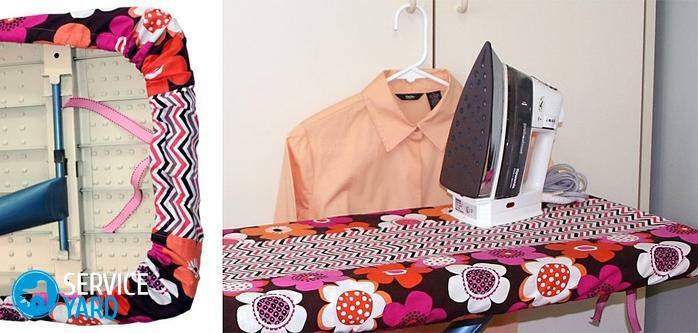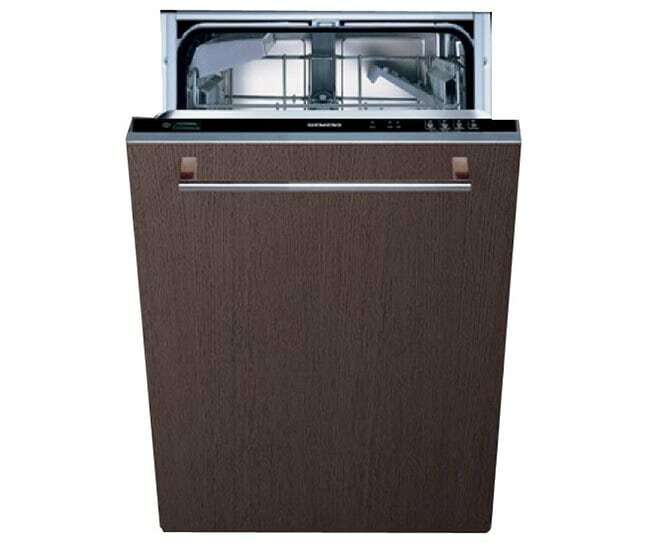
- Cover for ironing board
- Simple cover for wooden ironing board
- Sewing a cover on the ironing board with your own hands
The very process of ironing clothes and linen is not all fun. And if you also have to use a poor-quality iron or a fairly battered ironing board - and do not want to start the process, it will be difficult, and it will take much more time. With how you can clean the iron, so that it easily slides and ironed the fabric, we told you in other articles. In the same we will consider how to make a new cover on the ironing board with your own hands.
to the table of contents ↑Cover for the ironing board
The ironing board is the necessary and most important assistant for the care of your clothes. Its surface should be smooth and clean. Regardless of how often you use it, the ironing board cover becomes unusable with time, and ironing turns into torture. We will help you to cope with this problem.
Step by step we will consider the whole process. Let's start with the selection of materials.
What kind of fabric to choose?
First you need to pick up the material. A new cover will serve you more than one year, if you pick it right. The fabric for the ironing board cover should have the following characteristics:
- heat resistance - do not melt at high temperature;
- density - durable and smooth, but not sliding;
- does not shed.
Important! If there is a picture on the canvas, wash it in hot water and make sure that the drawing will not be reprinted.
All these requirements are matched with cotton fabrics:
- bleached coarse calico with a density of more than 145 g / m2.- when buying, contact the seller or look at the label on which the density is indicated;
- satin;
- teak;
- flannel.
Important! Choose a light fabric, without a pattern, so that the matter is solid.
As for dimensions - in order to sew the ironing board cover with your own hands, you will need:
- 60-80 cm of fabric with a width of 220 cm.
- If the width of the web is less than 1.5 m, the quantity must be calculated. To do this, measure the length of the board and the width. Measure the most distant points. Then add 20 cm to the width, and multiply by 2. The resulting digit and it will be the desired length.
Choosing the lining
Listening to the tips, you can choose the right lining.
Tip 1
The color of the material should be light tones, because under the influence of high temperatures and steam, your new cover will change color.
Important! Usually choose white batting, felt, sintepon or foam rubber.
Tip 2
It is better to give a white batting or felt. This kind of matter has a natural basis and some roughness. Due to this, it will be closer to the board, it will not slide.
Sealant made of sintepon or foam rubber under the influence of hot steam, quickly deteriorates.
Important! Batting or felt need to buy as much as the fabric.
to the table of contents ↑Simple case for wooden ironing board
Do you have a wooden model for ironing? Then you do not need a sewing machine. We will tell you in detail how to repair the ironing board with your own hands using a stapler for furniture. If you do not have such a tool in the house, then you can use small postal nails and a hammer.
Important! Nails do not completely clog. Leave ⅓ the parts of the nail. First, we slaughter everything on the contour of the board, then, when the cover is fully stretched, bend the nails one way.
Having prepared everything you need, let's get to work.
Important! Stretching the cover in this way, you will get a flat surface, on which there will be no wrinkles or creases.

Step-by-step instruction:
- Remove the old upholstery together with the cover. It is necessary that in the future the old case does not spoil your new one.
Important! The worn case can be used instead of a pattern. To do this, you need to cut it and smooth it well, attach it to the wrong side of the fabric and circle it with a pencil( the usual one used for drawing).
- Make a pattern for which it is necessary:
- lay the fabric on the floor, with the wrong side up;
- turn over the board and attach the upper part to the wrong side of the material;
- to outline the outline with a simple pencil, remove the board, retreat to the allowances of 5-8 cm, draw a solid line;
- cut.
Important! Place the board parallel to the width line of the fabric. If the cover is skewed, it will be problematic to pull it straight and correctly onto the board.
- The same actions should be performed with the batting, only allowances to make less - 3-6 cm.
- Patterns ready.
- Attach the batting to the board.
- We glue with glue "Moment" to the board along the contour.
- We pull the fabric, which will require:
- Fasten the fabric with a few staples( nails) on the back of the board( width, where the line is straight, not rounded), simultaneously fold the fabric along with the lining inside. To bend the edges it is necessary for 2-3 cm.
- Tighten the fabric forward secure with a staple in the middle on one side and on the other.
- By pulling the fabric, alternately left and right, you need to shoot the staples on both sides.
- Finally fix all the sections.
- The corners are laid like an envelope, on the underside of the board, firmly anchoring.
- Curvatures should be formed with the help of folds, also by fastening them with clamps( nails).
Important! Before proceeding to the constriction of the board, wash the material for the cover at a high temperature. Cotton fabric very often gives a great shrinkage.
to the table of contents ↑Sewing a cover on the ironing board with your own hands
Ironing boards nowadays are more often produced in the form of a metal frame covered with a mesh. For such models, the waist-neck method is not suitable, here it is necessary to sew the cover onto the ironing board with your own hands and pull it.
We will describe in a phased manner two ways how to sew a cover by oneself:
- With the first method, experienced seamstresses can easily cope.
- But the second is more suitable for beginners.
Important! Before you begin to sew a cover, you need to glue the lining blank to the board or shoot with staples. Do all the actions in the same order as when updating the wooden board.
Method 1
Material on the cover and lining - 60 cm with a cloth width of 220 cm. How to proceed:
- Cut the patterns as described above.
- To work edges:
- to bend all along the circumference of 0.5 cm and iron by iron;
- bend 1 cm and baste by hand, then stitch on the sewing machine, leave a 1-1.5 cm pass, for retracting the rubber bands.
Important! This process is best done first with your hands. So it will be neat and beautiful, especially rounded areas.
- Insert an elastic band or cord - let's talk about several methods. You can use any of your choice:
- Gum put on an English pin, pass into the treated edge, along the entire circumference fix both ends together.
Important! Correctly choose the length of the gum. If too small - it will be bad to put on a board, and a large one - not to fit tightly.
- Insert the cord in the same way, only pull out the ends and firmly tie.
- The method of "lacing" - you need to make small loops from the cord or fabric. Secure them with a machine stitch all around the circumference of the cover every 10-15 cm, symmetrically. Pass the cord from one end of the board to the middle, as if "lacing" the shoe, and from the other - similarly, to the middle.
Method 2
Sewing the cover for the ironing board with your hands using this method, you get a double-sided cover. It can be changed by the parties. One side can be made light - suitable for ironing white things, the other side is darker - for colored and dark things.
How to proceed:
- Make a pattern:
- you need to prepare 2 cuts - 60 cm and a width of fabric not less than 150 cm;
- add two cuts face-to-face, then make a pattern, as described above, give allowances of 10-15 cm and outline the contour, but at the end it is necessary to put marks where we will not stall.
- Sew a cover:
- it is necessary to retreat from the edge of the workpiece 1 cm and stitch exactly along the entire circumference, fixing it in the intended place;
- turn the product over the face, through the hole that was left;
- align along the line of stitching, iron by iron;
- the place of turning is sewn with the hands of the butt to the joint, leaving 2-3 cm, so that you can then swipe the elastic band;
- make the interval from the edge of the product 2-3 cm and lay a line around the entire cover.
- Insert the rubber band. Also, use a pin to draw in the elastic band and fasten it. Pull on the board.
Well, that's all - the cover on the ironing board with your own hands is ready, and your board in a new outfit is ready for a new test. We hope you managed to choose an easier way for yourself and you coped with the task without problems.


